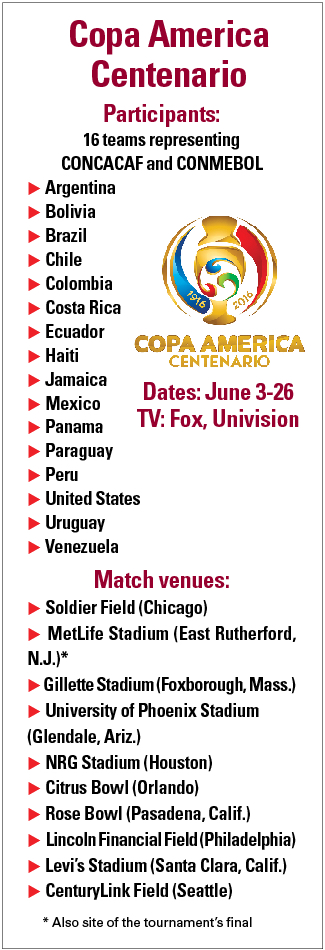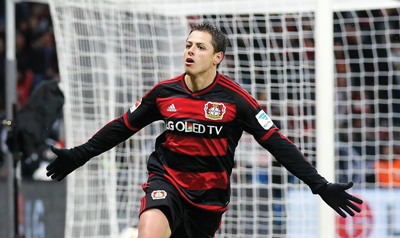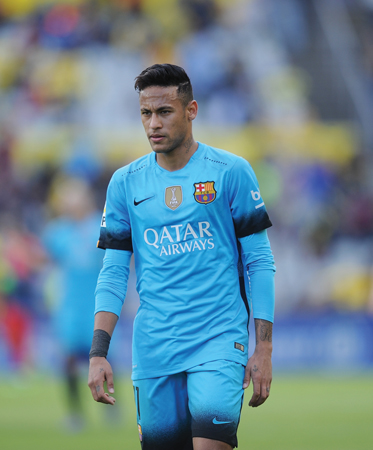Univision Deportes President Juan Carlos Rodriguez doesn’t hide his feelings about this summer’s Copa America Centenario event.
“Due to the stars, due to the teams, due to their relevance, due to it being a real official event in the United States in prime time … it’s going to be the biggest soccer event in the U.S. we’ve seen,” Rodriguez said recently.
It’s easy to see the potential. The three-week tournament, starting June 3, will feature the U.S. and Mexican men’s national teams in a field of squads from across the Americas and Caribbean, all of whom expect to be sporting their biggest stars, like Lionel Messi, Neymar and Chicharito. NFL stadiums will be the game sites; Coca-Cola, State Farm and Sprint have joined as new sponsors; and every game will be played in prime time, with coverage across both Univision and Fox.
Six months ago, the tournament’s future was in doubt, caught directly in the wave of scandal and corruption that rolled over FIFA and the international soccer community. Its standing has since been made secure, and major ad and sponsor efforts are underway, driven by the newly signed groups marketing the event.
Copa America Centenario adds to what’s become, annually, a full summer soccer schedule. There are the usual domestic events, among them MLS, NWSL, NASL and the International Champions Cup, now in its fourth year (see related story). There are the global players, including the UEFA Champions League Final and Euro 2016. There’s the addition of Olympic soccer in Rio this year, as well. Yet this one-off, uniquely scheduled, event could prove to be the biggest commercial, broadcast and on-site success of the lot.
That is exactly what CONMEBOL President Eugenio Figueredo and CONCACAF President Jeffrey Webb had in mind when they announced in May 2014 that the event, international football’s oldest competition, would leave South America for the first time to celebrate its 100th anniversary with a special tournament in the United States. It has been played 44 times previously, typically occurring every two or three years. Both Figueredo and Webb touted that the anniversary tournament would be the biggest international event in United States since it hosted the 2002 Winter Olympics.
FIFA’s Executive Committee agreed, placing the tournament on its official calendar. That action, in turn, requires club teams worldwide to allow their players to play in the event — meaning Argentina’s Messi and Brazil’s Neymar (FC Barcelona), Mexico’s Chicharito (Bayer Leverkusen), and the stars of other countries.
Roughly a year later, both Figueredo and Webb were arrested in Zurich as a result of the U.S. Department of Justice’s investigation into global soccer corruption and bid rigging — including millions of dollars in bribes tied to this event. The corruption issues went deeper. Sports marketer Datisa, a collective of three marketing firms, including U.S.-based Traffic Sports, had been selling both the sponsorship and broadcast rights for the tournament and was heavily implicated in the investigation.
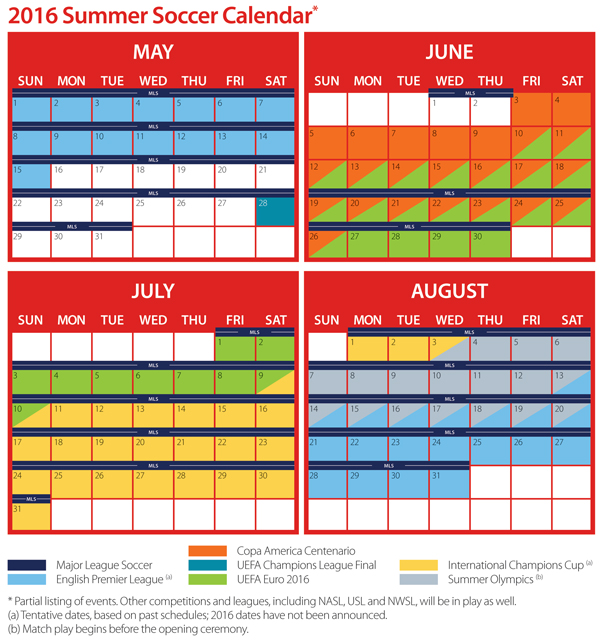
The tournament’s future quickly came into doubt.
“From the end of May last year to September, we questioned it, and there were certainly time periods within that where I would have bet against it happening, or at least bet against it happening in the U.S.,” said U.S. Soccer Federation President Sunil Gulati.
As the event’s local organizing group, the federation began a resuscitation effort, setting requirements that the tournament needed to reach — from transparency measures to stripping Datisa of its rights. All of those benchmarks were met, and the tournament was once again confirmed by organizers last fall. That included selecting Soccer United Marketing and IMG to market and sell the tournament’s commercial rights after a more transparent RFP process.
“There’s no debating the quality of the tournament or the excitement around these players. It’s like the best of the best,” said SUM President Kathy Carter. “We look at it as 32 games, 16 countries, 10 cities, all massive venues, and the best players the U.S., Mexico and South America have to offer.”
Carter acknowledged that the shortened run-up for the event — SUM and IMG were awarded the rights in December — has altered timelines. It also has the sales team playing catch-up. Nike was the only sponsor to remain with the tournament after the rights were stripped from Datisa; other primarily regional deals outside the United States came off the board.
Yet SUM and IMG have secured partnerships with Coca-Cola, State Farm and Sprint — all deals scheduled to be formally announced in the coming days — and Carter said she is confident organizers ultimately will secure what she calls “a blue-chip lineup” for the tournament.
She also noted that when SUM and IMG went into discussions with CONCACAF and CONMEBOL over the rights, the shortened timeline was not a mystery.
“We can’t manufacture time, so the challenge is really just the tight time frame and fighting the clock,” she said. “Everyone understands that if there was more time to plan, things would be different, but that doesn’t dilute the value of the tournament itself.”
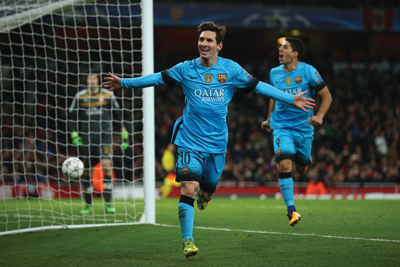 |
Lionel Messi, Chicharito (below) and Neymar (bottom) are expected to break from their club teams to compete in the tournament, an event that is on FIFA’s official calendar.
Photos by: GETTY IMAGES
|
John Guppy, founder and president of Gilt Edge Soccer Marketing, said the shortened timeline could force sponsors to engage differently with fans than how they might otherwise. While perhaps a consumer products company might not be able to bring its mark to retail via in-store visuals as quickly as it would prefer, the target audience for this tournament opens up plenty of opportunities for digital and social campaigns, he said, as well as on-site activation.
The agency has worked with clients ranging from Heineken and Pepsi to MLS and CONCACAF on past
executions.
“When it comes to the demographics that this tournament will reach — millennials, Hispanics and families — in terms of its scale, reach and the fact that it’s happening here, I really think it’s a game changer in terms of how much engagement it will have,” he said.
Expectations are similarly high at Fox
Sports.
“There are some unknowns here, but the biggest stars in the sport are choosing to play in this tournament, all the major countries in the Americas are committed, and you’ll have games taking place in the U.S. in U.S. time zones optimized for prime time,” said David Nathanson, Fox Sports’ head of business operations. “The stars are aligned for it to perform very, very well.”
Fox Sports paid approximately $15 million for the U.S. rights to the event, according to sources familiar with the deal. Nathanson declined to comment on financial terms. He did, however, acknowledge that there’s a certain learning curve tied to this year’s event. The non-core soccer fan who might tune in for a World Cup but otherwise isn’t a regular viewer of the game likely would need to be educated on what exactly this tournament is. Patriotism could assist in that regard — “It’s one of those times we can wrap ourselves around the American flag or whatever country you support,” Nathanson said — but the larger volume of soccer play slated for this year could assist as well.
“Right now, we’re starting our most competitive period of soccer programming, between the UEFA Champions League, the start of the MLS season, and U.S. men’s and Mexican national team [World Cup] qualifiers, so our ability to promote to an audience that would be interested could not be stronger,” he said. “When you look at our promotion of the Women’s World Cup last year — which we knew we had the rights for well in advance — we really only began promoting in earnest right around the Daytona 500, so we’re rather aligned with that.”
For Univision Deportes’ Spanish-speaking audience, that fan education doesn’t need to happen. Rodriguez said many already know the tournament as “a Hispanic soccer festival.” The addition of the U.S. and Mexican teams to the event — they have not been among the tournament’s usual participants — stands to make this centennial event even more impactful.
The 2014 FIFA World Cup final, for example, a match that featured Argentina and Germany, drew 9.2 million viewers on Univision, with another 450,000 watching through the network’s app. Yet the most-watched game of the tournament for Univision was a round-of-16 match between Mexico and the Netherlands, viewed by 10.4 million fans.
Rodriguez said the network is forecasting its ratings to be 8 percent to 10 percent higher than what it saw during the World Cup.
Univision has held its Spanish-language rights for Copa America Centenario since 2014, reportedly paying $60 million for the rights. Rodriguez declined to comment on the specific figures but did say, “Although the numbers that we paid are challenging, we will be able to generate earnings for the company.”
Where the short run-up till the event could perhaps be most evident is in some of the fan-facing commercial aspects of the tournament — including ticket sales.
“Any time you have this large of an event, more time is clearly better than less time, but since this is what we have, we’re working with it,” said Jay Berhalter, chief commercial director for the U.S. Soccer Federation and CEO of the Copa America local organizing committee.
Berhalter said he was expecting an uptick in sales for the event now that its schedule has been set. The participating clubs’ match times and locations were slotted last week. As those anticipated tickets sales come, he said, the numbers stand to make an impression beyond what any single match or domestic tournament might showcase.
“When you look back at the World Cup [in 1994, played in the United States], these players are not as abstract or unfamiliar as they might have been 20 years ago. Lionel Messi might be one of the most popular athletes in the U.S. in any sport,” Berhalter said. “We’ve seen a significant development of a fan culture here that will have its first real opportunity to be showcased on an international level during this tournament.”


